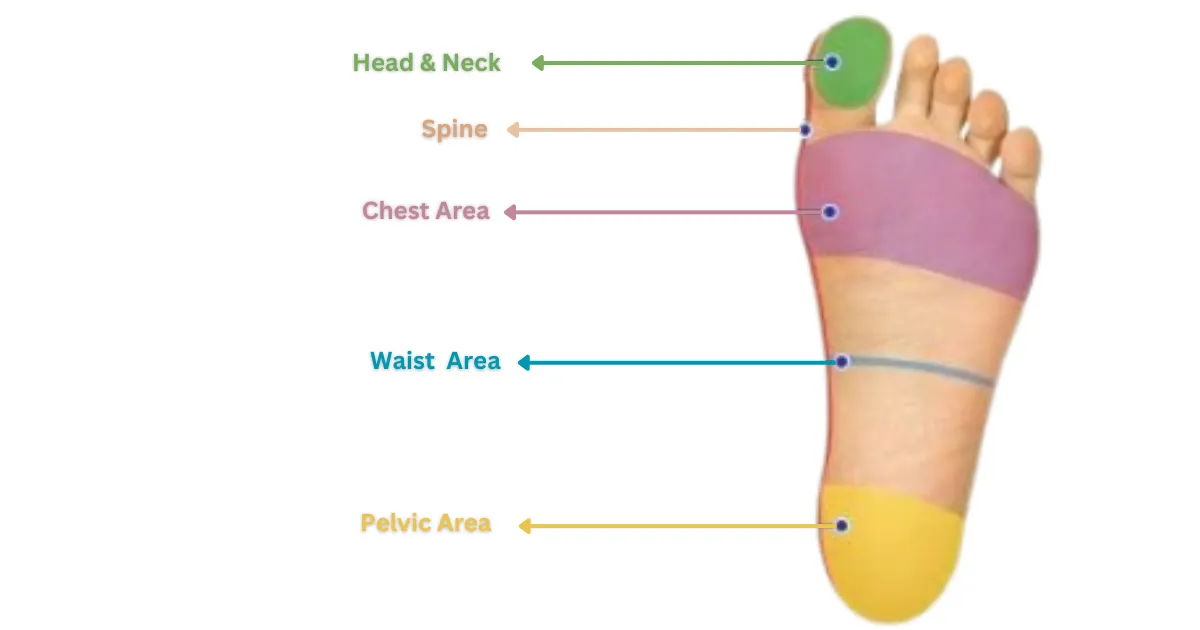
Health Benefits Of Reflexology: Physical & Mental
Have you ever heard of reflexology? It’s a fascinating alternative therapy that’s been gaining popularity for its many health benefits. Reflexology isn’t just a foot massage; it’s a therapeutic practice that can improve your physical and mental well-being. Let’s explore what reflexology is, its history, and why it’s becoming a crucial part of modern health routines.
Table of Contents
- Understanding Reflexology
- The Science Behind Reflexology
- Common Techniques Used in Reflexology
- Health Benefits Of Reflexology Physical & Mental
- Reflexology Mental Health Benefits
- Specific Conditions Alleviated by Reflexology
- Reflexology for Different Life Stages: Health Benefits
- How to Get Started with Reflexology
- DIY Reflexology Techniques
- Conclusion
- FAQS
Understanding Reflexology
How Reflexology Works: Reflexology involves applying pressure to specific points on the feet, hands, and ears. These points are believed to correspond with different organs and systems in the body. By stimulating these reflex points, reflexologists aim to promote health in the corresponding areas through energetic pathways.
The Science Behind Reflexology
While the exact mechanisms are still being studied, reflexology is thought to work through the nervous system, stimulating the release of endorphins, which are natural painkillers. Some theories suggest that reflexology may also help balance the body’s energy flow, similar to practices like acupuncture.
Common Techniques Used in Reflexology
Reflexologists use various techniques, including thumb walking, finger walking, and applying direct pressure. Each technique targets different reflex points and helps in relieving specific ailments.
Health Benefits Of Reflexology Physical & Mental
- Physical Health Benefits
- Pain Relief: One of the most well-known benefits of reflexology is pain relief. It’s particularly effective for chronic pain management and post-surgery recovery. By targeting specific reflex points, reflexologists can help alleviate pain in areas like the back, neck, and joints.
- Improved Circulation: Reflexology can significantly enhance blood circulation. Better circulation means more oxygen and nutrients are delivered to your cells, which can improve cardiovascular health and support the lymphatic system, helping in detoxification
- Enhanced Immune Function: Regular reflexology sessions can boost your immune system. By reducing stress and promoting relaxation, reflexology helps your body to fight off illnesses more effectively.
Reflexology Mental Health Benefits
Stress Reduction: Reflexology is excellent for stress relief. By regulating stress hormones and employing relaxation techniques, reflexology helps in reducing overall stress levels, making you feel calmer and more balanced.
Anxiety and Depression Management: For those struggling with anxiety and depression, reflexology can be a natural way to find relief. The practice promotes the release of endorphins, which are mood-enhancing hormones, and helps you achieve emotional balance.
Improved Sleep Quality: If you have trouble sleeping, reflexology might be the answer. It can help with insomnia relief and regulate your sleep cycles, ensuring you get a restful night’s sleep.
Specific Conditions Alleviated by Reflexology
Reflexology has been found to help with a range of specific health conditions
- Migraines and Headaches: By targeting pressure points associated with the head and neck, reflexology can reduce the frequency and intensity of migraines and headaches.
- Digestive Issues: Reflexology can aid in digestion by stimulating the corresponding reflex points on the feet and hands, helping alleviate issues like constipation and irritable bowel syndrome.
- Hormonal Imbalances: It can help balance hormones, which is beneficial for conditions like PMS, menopause, and thyroid problems.
- Arthritis and Joint Pain: Reflexology can reduce inflammation and pain in the joints, making it a valuable therapy for arthritis sufferers.
- Back and Neck Pain: By focusing on the spine’s reflex points, reflexology can provide significant relief from back and neck pain.
Reflexology for Different Life Stages: Health Benefits
Reflexology for Children
Benefits for Infants and Toddlers: Reflexology can be incredibly soothing for infants and toddlers. It helps with common childhood issues like colic, teething pain, and sleep disturbances
Reflexology for School-Aged Children: For school-aged children, reflexology can aid in reducing stress and anxiety, improving concentration, and boosting overall well-being.
Reflexology for Adults: Adults often face workplace stress, which can be mitigated through regular reflexology sessions. It helps in maintaining mental clarity and physical stamina.
Reflexology for Athletes: Athletes can benefit from reflexology by enhancing their performance, speeding up recovery, and reducing the risk of injuries.
Reflexology for Seniors: For seniors, reflexology can be a gentle way to manage chronic pain and improve mobility. It’s especially beneficial for conditions like arthritis and age-related
How to Get Started with Reflexology
Finding a Reflexologist
Research: Start by researching local reflexologists. Look for practitioners with certifications and positive reviews. Websites, social media, and word of mouth are good places to find recommendations.
Consultation: Once you find a potential reflexologist, schedule a consultation. This meeting allows you to discuss your health concerns, ask questions, and get a feel for their approach.
Qualifications: Ensure that the reflexologist is certified by a recognized body. Certification ensures that the practitioner has undergone proper training and adheres to professional standards
Preparing for Your Session
What to Wear: Wear comfortable clothing. You’ll need to remove your shoes and socks, so ensure your feet are clean and free from injuries.
Relaxation: Try to arrive a few minutes early to relax and get into a calm state of mind. Reflexology works best when you’re relaxed.
Health Information: Be prepared to provide your reflexologist with any relevant health information. This includes current medications, past surgeries, and any specific health concerns you want to address.
DIY Reflexology Techniques
If you prefer to start at home, there are simple reflexology techniques you can try yourself.
Basic Foot Reflexology
- Find a Comfortable Position: Sit in a comfortable chair or lie down.
- Relax Your Feet: Use your hands to gently massage and relax your feet.
- Identify Reflex Points: Use a reflexology chart to locate the reflex points on your feet.
- Apply Pressure: Use your thumb to apply gentle pressure to each reflex point. Start at the toes and work your way down to the heel. Spend extra time on areas that feel tender or sore.
- Finish with a Massage: After working on all the reflex points, finish with a gentle foot massage to relax and soothe your feet.
Hand Reflexology
- Prepare Your Hands: Sit comfortably and relax your hands.
- Massage Your Hands: Use your other hand to gently massage your hands, loosening any tight areas.
- Locate Reflex Points: Refer to a hand reflexology chart to find the reflex points on your hands.
- Apply Pressure: Using your thumb, apply pressure to each reflex point. Start with the fingers and move towards the palm.
- End with Relaxation: Conclude with a gentle massage to leave your hands feeling relaxed and rejuvenated.
Making Reflexology a Habit
To reap the full benefits of reflexology, consider making it a regular part of your health routine. Here are some tips:
- Schedule Regular Sessions: Whether you visit a professional or practice at home, aim for regular sessions. Weekly or bi-weekly sessions can provide significant benefits.
- Combine with Other Therapies: Reflexology can complement other therapies like massage, acupuncture, or yoga. Combining these practices can enhance your overall health and well-being.
- Listen to Your Body: Pay attention to how your body responds to reflexology. If you notice improvements, continue with your routine. If you experience any discomfort, adjust your technique or consult a professional.
Conclusion
Reflexology offers a holistic approach to improving both physical and mental health. From pain relief and improved circulation to stress reduction and better sleep, the benefits are extensive. By integrating reflexology into your health routine, you can experience a significant boost in your overall well-being.
Learn more about health-related treatment options. Click here
FAQS
- 1, What is reflexology?
- Reflexology is a therapeutic practice that involves applying pressure to specific points on the feet, hands, and ears, which correspond to different organs and systems in the body.
- 2. How often should you get reflexology?
- The frequency of reflexology sessions depends on individual needs, but typically once or twice a week can provide significant benefits.
- 3, Can reflexology help with chronic conditions?
- Yes, reflexology can help manage chronic conditions such as arthritis, migraines, and digestive issues by targeting specific reflex points.
- 4, Are there any side effects of reflexology?
- Reflexology is generally safe, but some people might experience mild side effects like nausea or dizziness. It’s important to consult with a healthcare professional if you have any concerns.
- 5, How do I find a good reflexologist?
- Look for a qualified and certified reflexologist with positive reviews and recommendations. You can also ask for referrals from friends or family.
Related Video | Health Benefits Of Reflexology
